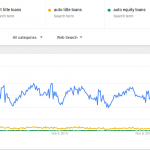Auto Loan Default Statistics
Auto Loan Default Statistics 2022-2021
- Defaults increased from auto loan lending standard decay.
- Q1-2020-to-Q2-2021 auto loan defaults rose from 4.17% to 4.64%.
- Millennial-driven increases in delinquencies lasted from 2014 to 2021.
- Subprime 90-days-overdue-or-greater defaults rose to decade-long high in 2021-2022.
- Proportion of auto to consumer debt hit 10-year high.
- Subprime delinquency rate hit highest mark since Q3 2009 in 2020-2021.
Auto Loan Default Statistics 2020-2019
Since the Great Recession ended in 2009, the United States economy has steadily, continually, consistently improved in terms of overall annual output as expressed by gross domestic product and unemployment rate. Virtually every other meaningful statistic financial analysts use to determine whether economies are doing well or not would also likely indicate positive economic performance. According to Business Insider, an uptick in auto loan defaults and buyouts and in Feb. 2019 was due to a breakdown of the American car lending market’s standards from 2011 to 2017. Another factor encouraging this negative economic indicator’s short-term spike in Feb. 2019 is the average U.S. consumer’s now-greater affinity for expensive SUVs and pickup trucks. This explained by the positive correlation of the likelihood of auto loan default with the cost of car notes.
From the end of the first quarter of 2021, or Q1 2021, to the close of the second quarter in 2019, or Q2 2019, the percentage of all auto loans that were then-currently past due or refinanced by a margin of at least 90 days increased from 4.17% to 4.64% of all outstanding car notes throughout the United States. If you look at this mathematically, the percentage growth is directly caused by a lack of domestic auto loan origination. Because outstanding delinquent loans don’t go away as quickly as new ones are created – at least this has been true for almost the entirety of the past decade – the aforementioned prevalence of 90-day-or-better overdue auto loans in the United States increased especially with no job. Much of this has to due with millennials, many of whom are weighed down by substantial student loans.
Because student loans are required to be paid back and you can have your wages garnished, your vehicle repossesed and your bank account levied for defaulting on them, millennials are less focused on auto loans and more worried about student loans. Also, more millennials are moving to major cities, where sharing rides and opting for public transportation are commonplace, thereby reducing their need to maintain much of the past decade’s auto loan origination rates.
Overall, 18- to 29-year-olds have been the single demographic most affected by auto loan delinquency rates in the United States. Although, as previously mentioned, quarter-on-quarter auto loan delinquency rates rose from Q1 2019 to Q2 2019, the only long-term delinquency rate increases took place from 2014 to 2016. This holds true for people aged 18 to 29. Because of this fact – that long-term delinquency rates haven’t increased much from Jan. 2017 to Dec. 2018 – any current auto loan delinquency statistics you find touted by financial experts as supposed indicators of looming economic failure here in the U.S. are ungrounded and not based on valid statistics or ideologies.
Credit scores, as you know, are important to lenders. They range from 300 to 850 here in the United States and were originally known as FICO scores. Prospective car note borrowers with FICO scores 619 and lower are well into subprime territory. In 2018, these not-so-great choices for car notes’ delinquency rates at least 90 days past due fell to 8.18% of all outstanding auto loans in the United States. This was the highest margin since 2010, just months after the Great Recession. Economic inequality has caused this recent uptick in subprime borrowers’ auto loan defaults.
By Q1 2019, the total proportion of auto loan debt to the entirety of American consumers’ outstanding debt – this includes other forms of financing like student loans, credit cards, title loan refinance, title loan buyout, revolving home-equity-backed lines of credit, and mortgages – rose to 9.36%, up from 5.82% in Q1 2010. Primarily, the fact that current outstanding auto loan balances at the time of origination hit at a record high relatively recently is largely responsible for this proportional shift.
As of the end of Q2 2019, the domestic subprime auto loan delinquency rate reached its largest 12-month increase since 2010, a bad financial time for the U.S., as the Great Recession just came to a close. Auto loan delinquencies at least 90 days overdue hit their highest rate in terms of the proportion of such long-overdue defaults to all outstanding auto loans since Q3 2009, just over a month after the Great Recession ended. A further decline is likely in the domestic market’s future – at least on the long-term horizon, that is.




